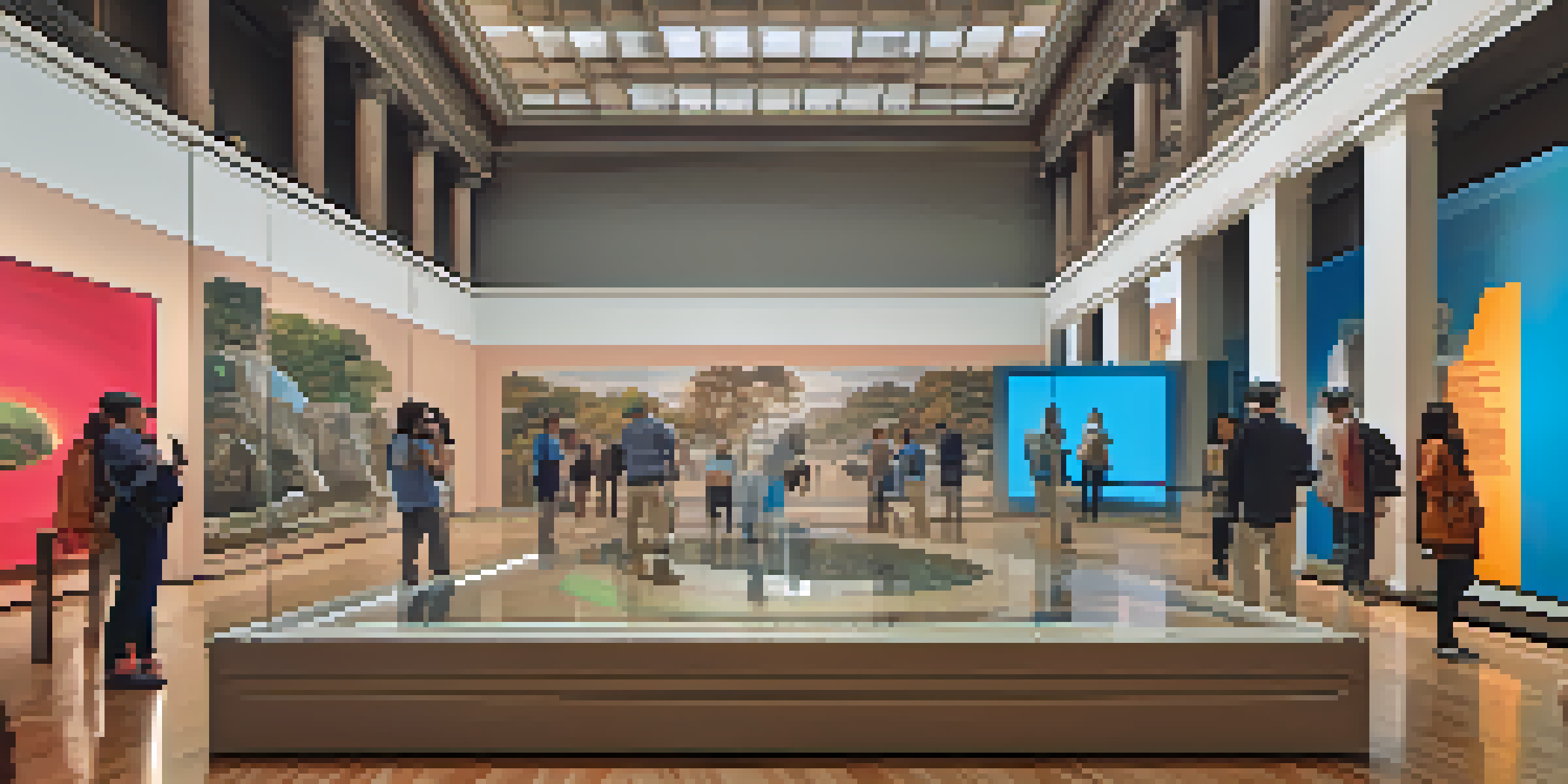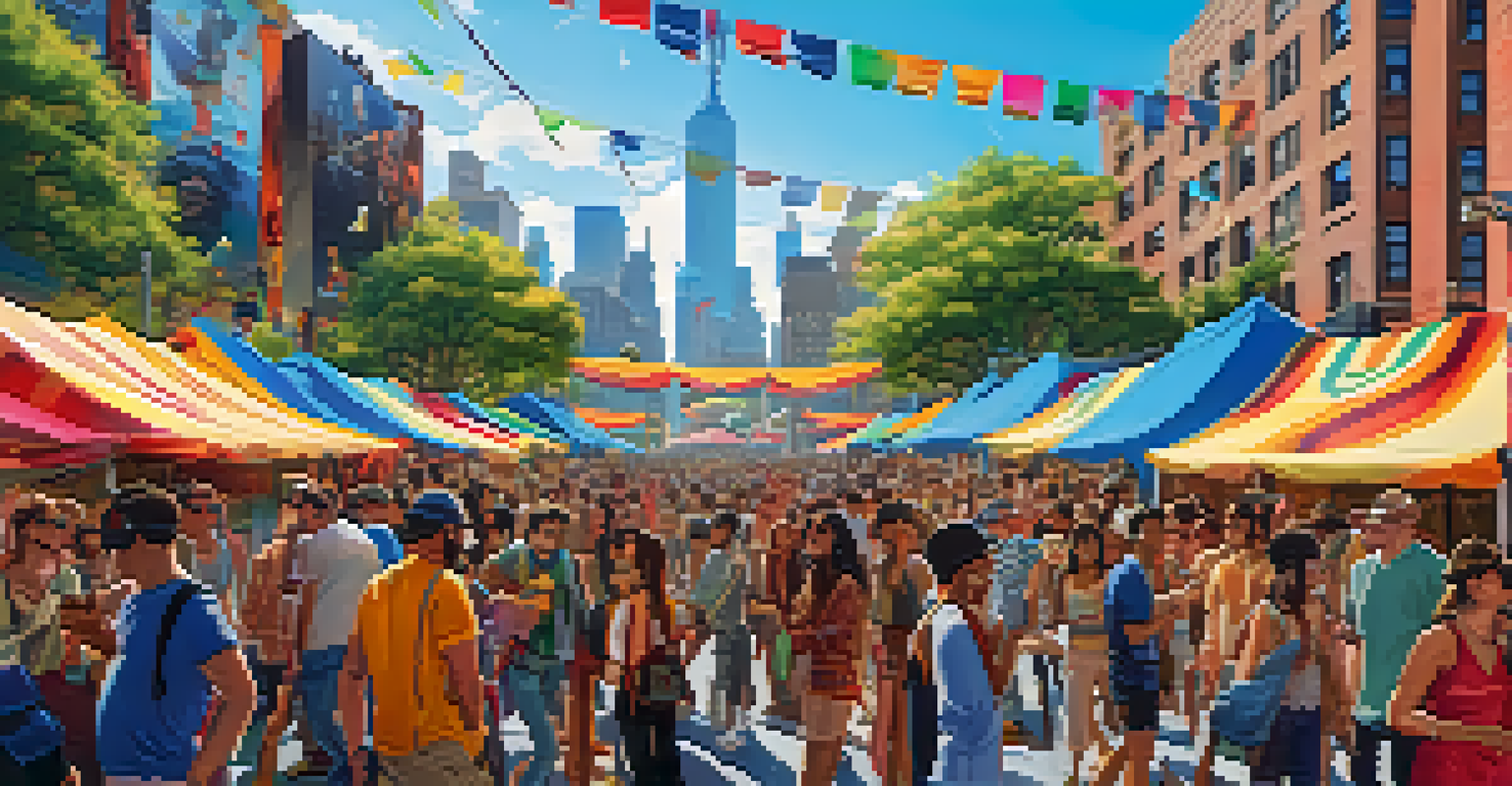Virtual Reality and Its Impact on NYC's Cultural Experiences

The Rise of Virtual Reality in Cultural Experiences
Virtual reality (VR) has emerged as a groundbreaking technology, reshaping how we engage with culture. In bustling cities like New York, VR isn't just a novelty; it’s becoming a standard part of cultural experiences. Museums, theaters, and galleries are increasingly incorporating VR to enhance storytelling and immerse visitors in their exhibits.
Virtual reality is the ultimate empathy machine.
For instance, imagine stepping into a VR simulation of an ancient civilization while visiting a history museum. This technology not only captivates the audience but also educates them in a more interactive manner. By merging technology with traditional cultural activities, VR is paving the way for a more dynamic and engaging experience.
As more institutions adopt VR, we can expect a significant shift in how culture is experienced, making it more accessible and relatable to a wider audience. This evolution is particularly relevant in a diverse city like New York, where the blend of cultures creates a fertile ground for innovation.
Enhancing Museum Visits with Virtual Reality
Museums in New York City are leveraging virtual reality to transform the visitor experience. With VR headsets, guests can explore exhibits in ways that were previously unimaginable, such as walking through a virtual recreation of a famous painting or experiencing historical events firsthand. This immersive experience not only captures attention but also deepens understanding.

For example, the American Museum of Natural History offers a VR experience that allows visitors to dive into the ocean and interact with marine life. Such experiences not only make learning fun but also encourage curiosity and exploration. By adding layers of immersion, museums are inviting a new generation of visitors to engage with art and science.
VR Transforms Cultural Engagement
Virtual reality is reshaping how we experience culture in NYC, enhancing storytelling and making cultural experiences more immersive.
The integration of VR into museum experiences is not just about entertainment; it’s about enhancing educational value. By making learning interactive and personal, museums can foster a deeper connection between the audience and the content, ensuring that cultural heritage is appreciated by all.
Theater and Performance Arts Embrace VR Technology
Theater and performance arts in NYC are also tapping into the potential of virtual reality to create unique experiences. With VR, audiences can be transported into the heart of a performance, experiencing it from multiple perspectives. This innovation is reshaping traditional stagecraft and expanding the boundaries of storytelling.
The future of storytelling is going to be more immersive and interactive than ever before.
Imagine sitting in your living room and watching a Broadway show where you can choose your vantage point, whether it’s backstage or front row. This level of engagement is not just exciting; it allows for a more personalized connection to the art. VR enables artists to experiment with new forms of expression, creating immersive narratives that go beyond conventional storytelling.
As the line between performer and audience blurs, VR is fostering a new form of interactive theater that invites participation. This shift could reinvigorate interest in theater, drawing in younger audiences who crave innovative experiences in the arts.
Cultural Festivals and Events Leveraging VR
Cultural festivals in New York City are embracing virtual reality to enhance their offerings. Events like the Tribeca Film Festival have begun to incorporate VR experiences, allowing attendees to immerse themselves in stories like never before. This trend not only enriches the festival experience but also broadens the understanding of the narratives being shared.
Imagine stepping into a VR installation at a festival, where you can interact with the environment and characters from a film. This interactive approach adds a new layer of excitement, attracting both film enthusiasts and casual attendees. VR installations can create buzz and foster discussions around the works presented, making the festival a more engaging experience.
Museums Use VR for Education
Museums are leveraging virtual reality to deepen learning and engagement, allowing visitors to interact with exhibits in innovative ways.
By incorporating VR into cultural events, organizers can create memorable experiences that resonate with a diverse audience. This approach also encourages collaboration between artists and technologists, leading to innovative projects that push the boundaries of creativity.
Education and VR: A Cultural Revolution
Virtual reality is not just changing how we consume culture; it's also revolutionizing education within the arts. Schools and universities in New York are beginning to integrate VR into their curricula, allowing students to experience art and history in immersive ways. This hands-on approach is particularly effective for engaging students with different learning styles.
For example, students studying art history can 'visit' famous art galleries worldwide without leaving their classroom. This exposure to global culture can inspire creativity and broaden perspectives, making learning more impactful. By using VR, educators can bring lessons to life, fostering a deeper appreciation for the arts.
This integration of VR in education is preparing the next generation for a world where technology and culture coexist harmoniously. As students become familiar with these tools, they are likely to become more innovative thinkers and creators, capable of exploring new avenues in the cultural landscape.
The Future of Virtual Reality in NYC's Cultural Landscape
As virtual reality continues to evolve, its role in New York City's cultural landscape is poised to grow even more significant. With advancements in technology, we can expect more sophisticated and accessible VR experiences that cater to a diverse audience. This evolution could redefine how cultural institutions engage with the public.
The potential for VR to create personalized experiences is particularly exciting. Imagine cultural institutions offering tailored VR tours based on individual interests or preferences, making each visit unique. This capability could enhance visitor satisfaction and foster a stronger connection to the cultural offerings of the city.
Theater Innovations with VR
VR is revolutionizing theater by offering audiences unique perspectives and fostering interactive performances that attract younger viewers.
As NYC embraces this technological shift, the fusion of culture and virtual reality will likely lead to new forms of artistic expression and community engagement. This promising future invites everyone to explore the myriad ways VR can enrich our understanding and appreciation of culture.
Conclusion: Embracing the VR Cultural Shift
In conclusion, virtual reality is not just a passing trend; it’s a transformative force in New York City’s cultural experiences. From museums to theaters, and educational institutions to festivals, VR is reshaping how we interact with art and history. This technology offers new ways to engage and connect with diverse cultural narratives, making them more accessible than ever.
As we embrace this cultural shift, it’s crucial to recognize the potential of VR to foster creativity and collaboration among artists, educators, and audiences alike. The intersection of culture and technology invites us to explore new possibilities, ensuring that cultural experiences remain relevant in our rapidly changing world.

Ultimately, the impact of virtual reality on NYC’s cultural landscape is just beginning to emerge. By continuing to innovate and adapt, we can look forward to a future where culture is experienced in ways that are as dynamic and diverse as the city itself.